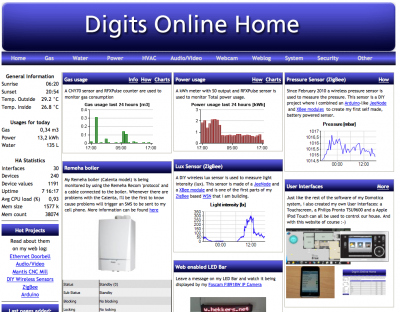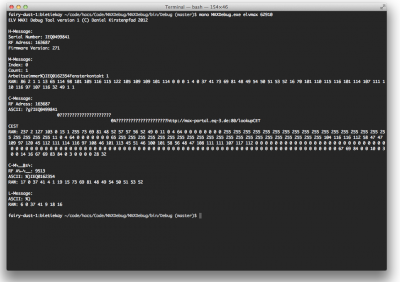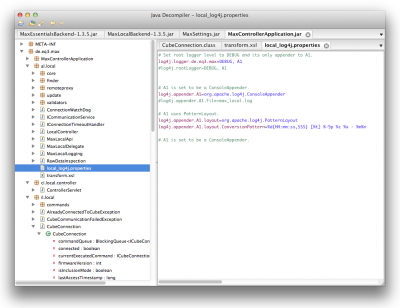For several years now I am interested in this home automation thing – I even got a little bit of my own home automation going. But with websites like domotica you can get an idea of what is achieveable and how it might look for the people actually using it every day.
reverse-engineering the ELV MAX! Cube protocol
I had a couple of hours to tinker with my ELV MAX! Cube and there is some progress with the protocol reverse engineering.
Of course there is the domotica forum helping out with some information the guys over there have found but in addition to their very helpful findings I want it to be integrated into h.a.c.s. – and along with it I maybe want to have a way to find eventual protocol changes quick and easy in the future.
So yesterday I partied on the ‘first contact’ – today I am a bit deeper into the protocol itself:
Here are some explanations to the picture:
When a tcp connection to the cube is opened you can immediately read from it – the cube is throwing information at you. There’s always a character at the beginning of each line which marks the type and beginning of the message.
There seem to be these types of messages in the first package of information:
- H – Header maybe?
- it contains the serial number of your cube, the RF address, the firmware version and several other things like time information
- M – Metadata?
- this seems to be some kind of global metadata list, containing the rooms with their IDs (it’s the %) in the screenshot). Furthermore it contains the serial numbers and names of the devices in that room – at the moment there’s just a window-state-sensor in that first room called “Fensterkontakt 1”
- C – Configuration?
- since there are multiple C messages these seem to contain detailed configuration data specific to a device in the MAX! network. Each device seems to be addressed by a RF Address and it’s serial number.
- the first C message in the screenshot is associated to the cube itself
- the second C message is associated to the window-state-sensor – you can clearly see in there the room id “%)” and the serial of the window-state-sensor.
- L – live status?
- this message seems to contain room status information. In our case there is only the room with id “%)”. When the window-state-sensor changes state the last byte changes value – interesting, eh?
On the coding side I’ve got several things set-up in my little debug tool. I’ve wrapped those message types into various classes to handle them more easily later on in h.a.c.s.. Furthermore I used a little decompiler-wisdom to extract some more information from the included ELV MAX! cube software.
Thanks to german UrhG paragraph § 69e (german copyright law) I am allowed to decompile the included software in order to achieve interoperability (and only that). That’s exactly what I would like to achieve: Interoperability. And for the record: besides that I also filed a support request to ELV in which I ask them if I could get access to a presumably existing documentation of that protocol.
While waiting on that documentation I am using JD-GUI as a decompiler user interface for java – since the software of the cube is written in java.
There are many interesting things in there but it’s a slow process to get ahold of all the things necessary. There are already some very nice things showing up. Like when you want to know if there’s a cube (or more) in the network you just need to send a multicast ip packet containing a characteristic signature and all the cubes in your network will try to connect back to you with some basic information – nice, isn’t it? Or what about that AES Encryption/Decryption that seems to be built into the cube? Yes that’s right! It seems to be possible to send commands to either encrypt or decrypt according to the AES. Thoughtfully these commands are marked with ‘e’ and ‘d’. Or that if you send “l:” as a command with CR+LF at the end you get a device listing with all stats… and so on.
Some open question to EQ-3/ELV for the end of this article:
- Why this strange protocol? Why all the work on both sides? Just because an HTTP server implementation with a RESTful service would have been that more difficult?
- Base64 encoded data? The 90s called, they want their 8th bit back.
- why that complex local webserver approach when you could have done everything in a java app anyways?
That’s it for today, I just pushed a feature to the Git repository which allows you to run whatever command you like on your cube with the debugging tool:
Enjoy! :-)
Source 1: http://www.domoticaforum.eu/viewtopic.php?f=66&t=6654&sid=f8f912914163cb44d447cfa3de44d63d
Source 2: http://en.wikipedia.org/wiki/Decompiler
Source 3: http://www.gesetze-im-internet.de/urhg/__69e.html
Source 4: http://java.decompiler.free.fr/?q=jdgui
Source 5: http://en.wikipedia.org/wiki/Advanced_Encryption_Standard



